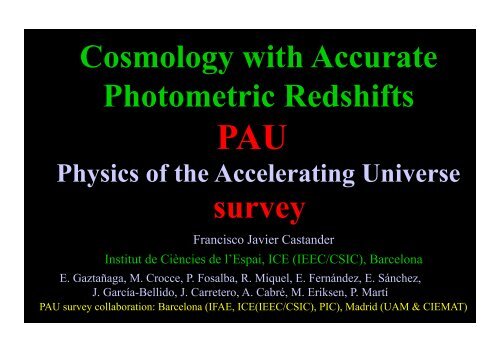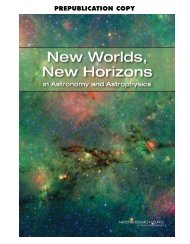PAU camera
PAU camera
PAU camera
- No tags were found...
Create successful ePaper yourself
Turn your PDF publications into a flip-book with our unique Google optimized e-Paper software.
Cosmology with AccuratePhotometric Redshifts<strong>PAU</strong>Physics of the Accelerating UniversesurveyFrancisco Javier CastanderInstitut de Ciències de l’Espai, ICE (IEEC/CSIC), BarcelonaE. Gaztañaga, M. Crocce, P. Fosalba, R. Miquel, E. Fernández, E. Sánchez,J. García-Bellido, J. Carretero, A. Cabré, M. Eriksen, P. Martí<strong>PAU</strong> survey collaboration: Barcelona (IFAE, ICE(IEEC/CSIC), PIC), Madrid (UAM & CIEMAT)
Probing Cosmology• Cosmology is probed mainly measuring the expansionrate of the universe H(z), the rate growth of structure g(z)• One way: survey to measure the distribution of matterP(k,z) with galaxies as tracers
Survey requirements• The precision to which the galaxy power spectrum can bemeasured depends on:• Sample variance: how many independent samples of therelevant scale (~100 Mpc/h for BAO) one has ⇒ volume• Shot noise (Poisson): how many galaxies included in eachsample ⇒ densityFeldman,Kaiser,Peacock,ApJ 426,23(1994)P(k): power spectrumn: galaxy density3
Requirements for cosmology survey• sample large volumes• sample enough (many) objects• measure distances (how accurate?)
The trick<strong>PAU</strong> survey• Use photometry to obtain redshifts• Many cosmological applications need only “rough”spectroscopic precision (~10 Mpc/h)• Broad band imaging does not provide enough resolution• Need sufficient spectral resolution as to obtain good photometricredshifts => narrow band imaging• Previously: Combo-17, Alhambra, COSMOS, Subaru,…• Simulations: MICE
Visual illustration of the importance of z resolutionz-space, Δz = 0.03(1+z) +peculiar velocitiesz-space, Δz = 0.003(1+z) +peculiar velocitiesz-space, perfect z-resolution+ peculiar velocitiesReal space, perfect resolution
Requirements on Redshift Precisionspec(H(z(z) d AphotoInverse of area of w 0 -w a error ellipsespecphoto(1+z) Δz /(1+z) Δz /Padmanabhan
Redshift SpaceDistortions
Lensing Magnification• Lensing efficiency kernel broad (cosmic shear need foraccurate photo-z’s?)• Good photo-z’s or redshifts allow you to perform crosscorrelationsbetween well-defined narrow redshift bins
Lensing Magnification• Lensing magnifies measured fluxes and alters the areaobserved and therefore changes the number of observedobjects in a magnitude limited survey• Coss-correlations between redshift bins i,j• Ratios of cross-correlations are approximately independent ofpower spectrum
<strong>PAU</strong> survey• The main goal of the <strong>PAU</strong> survey is to study cosmology/darkenergy characterising the geometry and growth of structure of theuniverse• Large volumes and moderately accurate redshifts are needed forthis purpose• The idea is to use a large field of view <strong>camera</strong> and narrow bandfilters to achieve both• The survey will use ~40 narrow band filters (~100 A wide)covering from 4500 to 8500 A supplemented by wide band filtersto image the sky and measure the position and distance (usingphotometric redshift techniques) to millions of galaxies
<strong>PAU</strong> survey• The <strong>PAU</strong> survey collaboration is in the process of building anew large field-of-view <strong>camera</strong> to be installed in the current primefocus of the WHT reaching an etendue of ~7 to carry a large areasurvey
The <strong>PAU</strong> CameraO. Ballester(2), L. Cardiel-Sas(2), J. Carretero(1), R. Casas(1), F. J. Castander(1), J. Castilla(3), M. Crocce(1), J.de Vicente(3), M. Delfino(4), E. Fernández(2), P. Fosalba(1), J. García-Bellido(5), E. Gaztañaga(1), F. Grañera(2),J. Jiménez(1), F. Madrid(1), M. Maiorino(2), P. Martí(2),R. Miquel(2), Ch. Neissner(4), R. Ponce(3), E. Sánchez(3), S. Serrano(1), I. Sevilla(3),N. Tonello(4), I. Troyano(2)(1)ICE (IEEC-CSIC), (2)IFAE, (3)CIEMAT, (4)PIC, (5)UAM14
The <strong>PAU</strong> Camera<strong>PAU</strong>Cam15
The <strong>PAU</strong> CameraTelescopio William HerschelLocated ORM, La Palma, Spain• Highly oversubscribedHigh scientific output so far•Diameter: 4.2 mPrime focus: 11.73 m•Focal ratio: f/2.8Used by UK, Netherlands & SpainL. Cardiel-Sas16
The <strong>PAU</strong> CameraTelescopio William Herschel•Located ORM, La Palma, SpainHighly oversubscribedHigh scientific output so farDiameter: 4.2 m•Prime focus: 11.73 m•Focal ratio: f/2.8Used by UK, Netherlands & SpainL. Cardiel-Sas17
The <strong>PAU</strong> CameraTelescopio William Herschel•Scale: 17.58 arcsec/mmL. Cardiel-Sas18
The <strong>PAU</strong> CameraTelescopio William HerschelCurrent prime focus corrector•Field of view: 40 arcmin unvignetted60 arcmin vignettedL. Cardiel-Sas19
The <strong>PAU</strong> CameraCamara efficiency•Fill the available field of view as densely populated as possiblewith CCD detectors•Use CCD with the highest QE available in the whole wavelengthrange accessible•Size: 2048 x 4096 pixelsPixel size: 15 µm•Scale: 0.26 arcsec/pix20
The <strong>PAU</strong> CameraDetectors• Hamamatsu21
The <strong>PAU</strong> CameraDistribution22
The <strong>PAU</strong> CameraDistribution23
The <strong>PAU</strong> CameraFilters40 narrow band filters•FWHM = 10.0 nm•Spectral Range λ=450 to 850 nmRectangular transmission profile24
The <strong>PAU</strong> CameraFilters6 standard broad band filters•SDSS + Y set25
The <strong>PAU</strong> CameraFilter TraysNeed to be very close to the detectors to avoid vignetting•More filters than detectors => movable trays•Movement requirements in vacuum are technologically challenging26
The <strong>PAU</strong> CameraFilter trays27
The <strong>PAU</strong> CameraElectronicsMonsoon arquitecture (NOAO) 3 clock and bias board •7 acquisi9on boards 3 master boards •18 pre-‐amp & rou9ng boards 28
The <strong>PAU</strong> CameraControl SystemSlow Control"Telescope"Control"System"TCS Instrument"Control"System"Alarms"Guider"Observa3on Control System Image View and Quality Analysis GUI Focal"Plane"Data Acquisi3on System 5-day"Storage"Transfer"to <strong>PAU</strong>dm Science Data Flow 29
The <strong>PAU</strong> Camera30
Main characteristics<strong>PAU</strong> <strong>camera</strong>• Large field of view• Narrow band filters + broad band filters• good spectral sensitivity• segmented filter trays
<strong>PAU</strong> survey• The <strong>PAU</strong> survey collaboration is in the process of building anew large field-of-view <strong>camera</strong> to be installed in the current primefocus of the WHT reaching an etendue of ~7 to carry a large areasurvey• The survey will obtain photometric redshift accuracy of dz/(1+z)
<strong>PAU</strong> survey: photo-z performance
<strong>PAU</strong> survey• The <strong>PAU</strong> collaboration is in the process of building a new largefield-of-view <strong>camera</strong> to be installed in the current prime focus ofthe WHT reaching an etendue of ~7 to carry a large area survey• The survey will obtain photometric redshift accuracy of dz/(1+z)
FOM 1/σ(w0) σ(wa) 1/σ(γ) 1/σ(w0) σ(wa)σ(γ)DES (MAG) 47 (109) 35 (48) 1.6 (5) x 10 3 DESpec (MAG) 116 (401) 77 (84) 9 (34) x 10 3 DESpec (MAG+RSD) 1430 (1736) 127 (141) 182 (245) x 10 3 <strong>PAU</strong>200 (MAG+RSD) 171 (195) 31 (33) 5 (6) x 10 3 Om - ODE - h - sig8 - Ob - w0 - wa - gamma - ns - b1- db1dz- b2- db2dz+Planck+ Stage-SN II (assume bias is known)FoM 5 8 25 17 200 DESpec/DES:Factor of 4 in Growth & 30 in DEfactor of 10 in joinned FoM
• Galaxy evolution<strong>PAU</strong> SurveyAlthough the survey is designed and optimized for DE,many other science topics could be addressed• Galactic astronomy• High redshift galaxies• Interstellar dust• Quasars and Lyα systems• Clusters• Stellar populations• Halo stars• Local group galaxies• Serendipitous discoveries• Weak gravitational lensing• Strong gravitational lensing
<strong>PAU</strong> survey• some cosmological probes do not require accurate spectroscopicredshift• exploit this with a narrow band survey delivering good photo-z’s• building a new <strong>camera</strong> for the WHT• probes: BAO (area), z-space distortions, magnification bias• sampling the galaxy power spectrum will not be limited by shotnoiseand could be traced with several tracers
DES landscape• If and when LSST operates, DECam will be out-dated• DESpec role• If DESpec is delayed or cannot happen, using narrow band filtersmay be an option for DECam
















